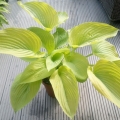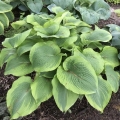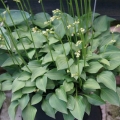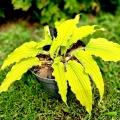Online Shop
130
Royal Horticultural Society
Gold Medals
Royal Horticultural Society
Gold Medals
- Home
- Other Plants
- About Bamboos
About Bamboos
Bamboo is a tribe of flowering, perennial, evergreen plants in the grass family. Giant bamboos are the largest members of the grass family. The regions of the stem (culms) are always hollow and they are regarded as one of the fastest-growing plants on Earth, with reported growth rates of 1m in 24 hours.
The growth rate, however, is dependent on local soil and climatic conditions, as well as species, and a more typical growth rate for many commonly cultivated bamboos in temperate climates is in the range of 3-10cm per day during the growing period. Primarily growing in regions of warmer climates, some of the largest timber bamboo can grow over 30m tall, and be as large as 15-20 cm in diameter. However, the size range for mature bamboo is species dependent, with the smallest bamboos reaching only 10cm high at maturity.
Bamboos are making a bit of a comeback in British gardens. Ideal for screening, fencing and a quick fix for a planting area, they are now more popular than ever. They withstand hot temperatures, but are of course fully hardy.
We stock a range of exciting bamboos of different heights to brighten up your garden design.
How Bamboo Grows
Bamboo is a member of the grass family. The stems that you will receive in the pot will not grow any taller or thicker. As the root system develops new shoots will appear in spring. These will be taller and thicker stems than the previous year's stems until the optimum height is reached as the years go by. So the oldest stems are the smallest. Bamboo does not grow like a tree.
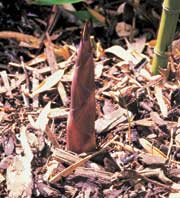
A new emerging shoot in spring.
Note how much thicker it is than the previous year's stem at the top left.
Selection of the Site
Select the position for your bamboo carefully. Most bamboos are reasonably behaved, as in the clump forming bamboos of Borinda, Drepanostachyum and Fargesia. Height is probably the most important factor you will need to consider, as well as the amount of sun received - contrary to popular belief, not all bamboo like to be in full sun.
Growing very tall bamboos over 5m will require a space of at least 1.25m square and with the 6m and taller bamboos a space of 2m square would be better.
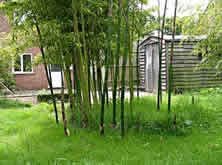
Phyllostachys praecox will grow to over 6m and requires ample space.
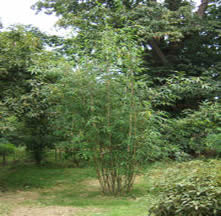
The newly introduced tall growing Borindas do
not take up so much area to achieve their potential.
Some bamboo are rampant spreaders and will often need plenty of space or containing to prevent them from spreading too far. Mostly these are of the genus Sasa. Containing can be done by digging a barrier to encicle the plant to stop the rhizmoe system spreading where you do not wish it.
Planting
Dig a large hole, twice the depth and spread of the rootball of the plant, this will give the bamboo open ground in which to establish itself over the first few years. Dig in plenty of organic matter, (we use mushroom compost or well-rotted manure) particularly if your ground is sandy or poor in nutrients. Plant the bamboo so that the rootball is buried maybe an inch (2-3 cm) under the surface as this will provide stability and help retain water. Bamboo will survive almost anywhere, but will do exceptionally well if given plenty of healthy nutritious food and water. Water is especially necessary in spring when the new shoots are extending and requiring a lot of water. Very heavy watering once a week is better than a little every day. Giving a lot of water will mean that you will have watered the root system to the bottom. We have noticed that the newly introduced Borindas require a lot of water in the spring and will readily abort their new shoots if they are on the dry side.
Aftercare
Water your bamboo well until the plant is established and feed every other year in late spring (i.e. after the first shoots have emerged and reached full height), preferably with a mulch of well-rotted manure or a multi-nutrient feed.
With Phyllostachys and Semiarundinaria bamboos, which have more open groves with strong outstanding culms, every two to three years remove the smaller, weaker canes. This leaves the more upright stronger culms to show off their best and allows more light into the centre of the grove. With Fargesia and other clump forming bamboos this is usually not necessary. Some dwarf bamboos may benefit from cutting back to the ground in mid-spring as the new growth appears to help promote leaf growth and vigorous shooting.
The growth rate, however, is dependent on local soil and climatic conditions, as well as species, and a more typical growth rate for many commonly cultivated bamboos in temperate climates is in the range of 3-10cm per day during the growing period. Primarily growing in regions of warmer climates, some of the largest timber bamboo can grow over 30m tall, and be as large as 15-20 cm in diameter. However, the size range for mature bamboo is species dependent, with the smallest bamboos reaching only 10cm high at maturity.
Bamboos are making a bit of a comeback in British gardens. Ideal for screening, fencing and a quick fix for a planting area, they are now more popular than ever. They withstand hot temperatures, but are of course fully hardy.
We stock a range of exciting bamboos of different heights to brighten up your garden design.
How Bamboo Grows
Bamboo is a member of the grass family. The stems that you will receive in the pot will not grow any taller or thicker. As the root system develops new shoots will appear in spring. These will be taller and thicker stems than the previous year's stems until the optimum height is reached as the years go by. So the oldest stems are the smallest. Bamboo does not grow like a tree.

A new emerging shoot in spring.
Note how much thicker it is than the previous year's stem at the top left.
Selection of the Site
Select the position for your bamboo carefully. Most bamboos are reasonably behaved, as in the clump forming bamboos of Borinda, Drepanostachyum and Fargesia. Height is probably the most important factor you will need to consider, as well as the amount of sun received - contrary to popular belief, not all bamboo like to be in full sun.
Growing very tall bamboos over 5m will require a space of at least 1.25m square and with the 6m and taller bamboos a space of 2m square would be better.

Phyllostachys praecox will grow to over 6m and requires ample space.

The newly introduced tall growing Borindas do
not take up so much area to achieve their potential.
Some bamboo are rampant spreaders and will often need plenty of space or containing to prevent them from spreading too far. Mostly these are of the genus Sasa. Containing can be done by digging a barrier to encicle the plant to stop the rhizmoe system spreading where you do not wish it.
Planting
Dig a large hole, twice the depth and spread of the rootball of the plant, this will give the bamboo open ground in which to establish itself over the first few years. Dig in plenty of organic matter, (we use mushroom compost or well-rotted manure) particularly if your ground is sandy or poor in nutrients. Plant the bamboo so that the rootball is buried maybe an inch (2-3 cm) under the surface as this will provide stability and help retain water. Bamboo will survive almost anywhere, but will do exceptionally well if given plenty of healthy nutritious food and water. Water is especially necessary in spring when the new shoots are extending and requiring a lot of water. Very heavy watering once a week is better than a little every day. Giving a lot of water will mean that you will have watered the root system to the bottom. We have noticed that the newly introduced Borindas require a lot of water in the spring and will readily abort their new shoots if they are on the dry side.
Aftercare
Water your bamboo well until the plant is established and feed every other year in late spring (i.e. after the first shoots have emerged and reached full height), preferably with a mulch of well-rotted manure or a multi-nutrient feed.
With Phyllostachys and Semiarundinaria bamboos, which have more open groves with strong outstanding culms, every two to three years remove the smaller, weaker canes. This leaves the more upright stronger culms to show off their best and allows more light into the centre of the grove. With Fargesia and other clump forming bamboos this is usually not necessary. Some dwarf bamboos may benefit from cutting back to the ground in mid-spring as the new growth appears to help promote leaf growth and vigorous shooting.
New Additions
-
Wundergold £15.00

-
Unruly Child £14.00

-
Twin Cities £11.00

-
venusta 'Porter' £8.00

-
Valley's Love Birds £10.00

